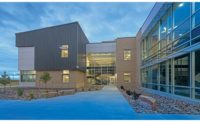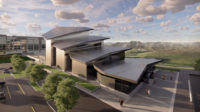“While Utah has been a strong market for HDR's work with roads and highways, Denver has solid activity related to transit,” says Bill Raleigh, western regional director and executive vice president.
HDR's work continues on Denver's West Corridor, part of the Regional Transportation District's multibillion-dollar FasTracks project. The West Corridor is a 12.1-mile light-rail line between the Auraria Campus in downtown Denver and the Jefferson County Government Center in Golden.
As a subconsultant to David Evans & Associates, Denver, HDR designed two light-rail bridges on the corridor. HDR is also working on the Eagle P3 commuter rail project as part of Denver Transit Partners, a joint venture led by Fluor/Ames/BBRI. Fluor/HDR Global Design LLC is the lead designer.
The Denver and Salt Lake offices were two of 17 HDR offices that provided design support services for the recently completed Hoover Dam Bypass project in Nevada, which won HDR an American Council of Engineering Companies' Grand Conceptor Award for the second year in a row.
Expertise-Driven Projects
HDR's Rocky Mountain architecture arm specializes in projects requiring expertise in science/biotechnology or academic and government laboratories. Over the past five years, HDR's architecture office has grown from a six-person design team in Denver to 34 professionals in Denver, Boise and Salt Lake City.
Expertise-driven projects provide a stable base in a fluctuating economy, says senior project manager Tom Whetstone. He points to significant recent projects such as an addition to the Joint Institute of Laboratory Astrophysics in Boulder, a laboratory project for the University of Colorado and the National Institute of Standards and Technology, due for completion in November, and the Wyoming Combined Laboratories Facility in Cheyenne, completed in January.
Phase three of the University of Colorado Hospital expansion is currently in design and under construction in Aurora and scheduled for completion in 2013. Modern Healthcare magazine ranked HDR No. 1 in health-care architecture for the eighth consecutive year.
Raleigh says that during the recession, the firm has been able to maintain a backlog and actually borrow labor from offices more affected by the recession. “Our long-term strategies of having diversified services have paid off, as we have been able to grow in nontraditional or emerging markets,” he adds.
While market diversity has certainly been key to HDR's recent success—helping the company to grow and not just survive—during an economic downturn, Raleigh says the firm has also looked beyond local/regional services in the mountain states and created national centers for specific areas of expertise. Key examples are the Environmental, Operations and Construction (EOC) subsidiary based in Englewood, Colo.; the military planning group in Colorado Springs; and the power-delivery group in Billings, Mont.
HDR/EOC, formerly Engineering and Environmental Management Inc., a company of 400 people purchased by HDR in 2009, is currently working on a construction oversight project in Afghanistan and gearing up for a transmission line project in Nevada. The office also had close to 70 people supervising the delicate cleanup related to last year's BP oil spill in the Gulf of Mexico.
“We have been able to grow from these new emerging markets and services, and we have been able to add traditional services to these new clients to provide a full range of services.” Raleigh says.




Post a comment to this article
Report Abusive Comment